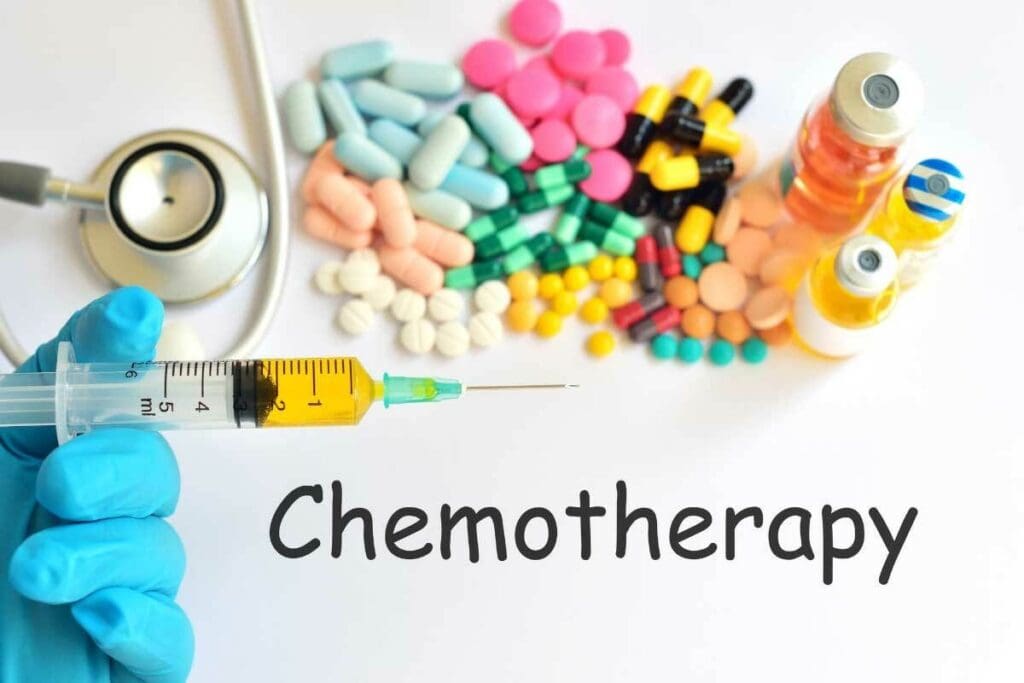Last Updated on November 20, 2025 by Ugurkan Demir

Leukemia treatment is changing with oral chemotherapy drugs. These drugs let patients take their medicine at home. This change has made life better for those with leukemia and opened new treatment paths.
Oral chemotherapy drugs, or chemo pills, have changed how we treat medication for leukemia cancer. At Liv Hospital, we offer trusted, patient-focused care. We are a top choice for the best oral treatments for blood cancer.

Oral chemotherapy has changed how we treat leukemia. It offers patients easier and more flexible treatment options. This change comes from new research and oral medications.
Oral chemotherapy has changed how leukemia patients get treated. Unlike IV chemotherapy, which needs hospital visits, oral meds can be taken at home. This makes life better for patients.
The move from IV to oral chemotherapy is big for leukemia patients. Oral meds are easier to use and more flexible. This helps patients manage their treatment better.
Most AML chemotherapy drugs are given IV, but some are now pills or skin injections. This gives patients more options and can lead to better results for some leukemias.
| Treatment Type | Administration Method | Patient Benefits |
| IV Chemotherapy | Intravenous infusion | Requires frequent hospital visits |
| Oral Chemotherapy | Oral pills or capsules | Can be taken at home, more convenient |
Oral chemotherapy has made patient care better. It lets patients take treatment at home, making life easier. This has improved their quality of life.
Studies show oral chemotherapy works as well as IV for some leukemias. This has made oral meds more popular. It gives patients more choices and better results.

It’s important to know how chemotherapy for leukemia works. They are a key part of treatment and offer benefits over traditional IV chemotherapy. Oral chemotherapy gives patients more control over their treatment.
Chemo pills for leukemia target cancer cells in different ways. Targeted therapies like venetoclax and ibrutinib block proteins that leukemia cells need to survive and grow. Other drugs, like fludarabine and cyclophosphamide, stop cancer cells from making copies of themselves by messing with DNA.
These oral medications are grouped by how they work:
Each type targets leukemia cells in its own way. This gives doctors a range of options to match each patient’s needs.
The success of oral chemotherapy depends on how well the body absorbs the drug. Bioavailability is how much of the drug actually works in the body. Things like the drug’s form, whether food is eaten, and the patient’s gut health affect this.
Some drugs need to be taken on an empty stomach for better absorption. Others might need food to lessen stomach side effects. Knowing these details is key to getting the best results from treatment.
Oral chemotherapy is often just as good as IV chemotherapy, but it’s easier to take and might have fewer side effects. Research shows that some oral drugs work as well or even better than IV drugs for certain patients.
For example, venetoclax is very effective against CLL and has fewer side effects than some IV treatments. But whether to use oral or IV chemotherapy depends on many things, like the leukemia type, the patient’s health, and past treatments.
Venetoclax is a BCL-2 inhibitor that targets cancer cells in CLL and AML. It works by blocking the BCL-2 protein. This protein helps cancer cells avoid dying.
Venetoclax focuses on the BCL-2 protein, key for some cancer cells. By blocking it, Venetoclax makes these cells die. This is very effective in CLL, where BCL-2 is often too high.
Venetoclax is specific to BCL-2, which means it harms fewer normal cells. This is a big step forward in treating CLL and AML.
The dose of Venetoclax starts low to avoid a dangerous side effect. It slowly increases over weeks. This helps doctors watch for any bad reactions.
Venetoclax can be used alone or with other drugs like rituximab. This flexibility helps doctors tailor treatment to each patient’s needs.
Studies show Venetoclax works well for CLL and AML patients, even those who’ve tried other treatments. The success rate varies based on the patient and treatment plan.
Venetoclax has also been shown to extend life and improve the quality of life for some patients. Its ability to cause deep remissions makes it a promising option for many.
Ibrutinib (Imbruvica) is a groundbreaking BTK inhibitor used in treating various B-cell leukemias. It has significantly improved treatment outcomes for patients with certain types of blood cancers.
Ibrutinib works by inhibiting Bruton’s tyrosine kinase (BTK), a key enzyme in the B-cell receptor signaling pathway. This pathway is often dysregulated in B-cell malignancies, leading to uncontrolled cell proliferation and survival. By blocking BTK, ibrutinib disrupts this signaling, inhibiting the growth of malignant B-cells.
Ibrutinib has shown efficacy in treating several B-cell leukemias, including Chronic Lymphocytic Leukemia (CLL), Mantle Cell Lymphoma (MCL), and Waldenström’s Macroglobulinemia (WM). Its ability to target specific molecular mechanisms makes it a valuable treatment option for these conditions.
While ibrutinib offers significant benefits, long-term treatment considerations are critical. Patients on ibrutinib require regular monitoring for side effects, including cardiovascular events and bleeding risks. Managing resistance and optimizing dosing strategies are areas of ongoing research.
Choosing the best medicine for leukemia depends on the disease subtype, genetic markers, and patient health. Ibrutinib’s role as a BTK inhibitor has made it a critical component in the treatment arsenal against B-cell leukemias.
Fludarabine is a key purine analog in CLL treatment, bringing hope to patients. Oral chemotherapy advancements have made more leukemia treatments available. Fludarabine leads this progress.
Fludarabine stops DNA synthesis in cancer cells. As a purine analog, it gets into DNA, causing it to stop growing. This is key in fighting CLL.
Fludarabine stops DNA growth by blocking enzymes needed for DNA replication. This leads to cancer cell death, reducing CLL tumors.
Fludarabine is often paired with other drugs to boost its effect. The FCR (Fludarabine, Cyclophosphamide, and Rituximab) combo has greatly improved CLL patient outcomes.
| Combination Regimen | Components | Efficacy |
| FCR | Fludarabine, Cyclophosphamide, Rituximab | Improved response rates and overall survival |
| FC | Fludarabine, Cyclophosphamide | Effective in CLL treatment, though less than FCR |
Choosing patients for Fludarabine involves looking at age, kidney health, and past treatments. It’s important to check blood counts, kidney function, and watch for infections or side effects.
Because Fludarabine weakens the immune system, patients need close watch for infections. Regular check-ups and lab tests help manage side effects and adjust treatment.
Cyclophosphamide, also known as Cytoxan, is a key drug in treating many types of leukemia. It has been a mainstay in chemotherapy for years. It offers a valuable treatment option for patients with different leukemia forms.
Cyclophosphamide works well against several leukemia subtypes, like CLL, ALL, and lymphoproliferative disorders. It works by alkylating DNA, which stops cancer cells from growing.
Its flexibility makes it useful in many chemotherapy plans. It can be used alone or with other drugs. This lets doctors create treatment plans that fit each patient’s needs.
The FCR protocol, which includes Fludarabine, Cyclophosphamide, and Rituximab, is a key treatment for CLL. It has shown better results and survival rates for many patients.
These combination regimens are more effective than single-agent therapies. This makes cyclophosphamide a vital part of leukemia treatment today.
Cyclophosphamide is effective against leukemia but can harm fertility. It can lead to infertility in both men and women.
Patients who can have children should talk to their doctors about preserving fertility before treatment. Long-term survivors may face risks of secondary cancers and other late effects. They need ongoing care and monitoring.
Understanding cyclophosphamide’s benefits and risks helps healthcare providers manage patient care better. This improves treatment results.
For those with leukemia that doesn’t respond to the first treatments, bendamustine brings new hope. It’s a hybrid alkylating agent. Bendamustine is effective in treating chronic lymphocytic leukemia (CLL) and non-Hodgkin lymphoma (NHL). It works well when other treatments have failed.
Bendamustine’s success comes from its unique chemical structure. It combines an alkylating agent and a purine analog. This mix helps it kill cancer cells in different ways. It’s great for treating resistant diseases.
Studies show bendamustine works well for CLL and NHL patients who didn’t respond to other treatments. It’s a valuable option for these patients.
Key benefits include:
Bendamustine is given intravenously on days 1 and 2 of a 28-day cycle. The number of cycles depends on how well the patient responds and how well they can handle it. Adjustments are made based on kidney function and blood counts.
Research is ongoing to improve bendamustine’s dosing and treatment cycles. This ensures patients get the best treatment with fewer side effects.
Chlorambucil, also known as Leukeran, has been a key part of leukemia treatment for years. It’s a traditional alkylating agent that helps manage different leukemia types. At Liv Hospital, we value Chlorambucil in our mission to offer top-notch healthcare. We support international patients fully.
Chlorambucil has a long history in fighting leukemia, starting many years ago. It was first used for chronic lymphocytic leukemia (CLL). Now, it’s used for other leukemia types too. Ongoing research keeps improving its use in treatments.
Chlorambucil is great for low-intensity treatments, which is good for elderly patients. These patients might have other health issues or can’t handle stronger treatments. It’s a gentle yet effective option for them.
We think about age and health when choosing treatments.
Using Chlorambucil means finding the right balance between its benefits and side effects. We aim to maximize its effectiveness while reducing its downsides. This careful approach is essential for our patients’ well-being.
Idelalisib is a new hope for treating relapsed leukemia. It works by targeting the PI3K pathway, which is often broken in some leukemias. This targeted therapy aims to improve patient outcomes.
Idelalisib blocks the delta isoform of PI3K. This is key because it only affects cancer B-cells, not healthy cells. It stops the PI3Kδ pathway, which helps leukemia cells grow and survive.
Key aspects of idelalisib’s mechanism include:
Idelalisib is approved for patients with relapsed or refractory CLL and some non-Hodgkin lymphomas. It’s a valuable option for those who’ve tried other treatments.
Clinical trials have shown that idelalisib, with rituximab, boosts survival and response rates in CLL patients.
Idelalisib is effective but comes with risks. Patients need to watch for liver issues, diarrhea, and pneumonitis.
Risk management strategies include:
Understanding idelalisib’s benefits and risks helps doctors use it wisely. This improves treatment outcomes and quality of life for patients with relapsed leukemia.
Choosing the right oral medication for leukemia is a personal matter. It depends on many factors. What works for one person might not work for another.
Genetic and molecular testing are key in picking the right treatment. These tests find specific genetic changes that affect how well a patient responds to a drug. For example, some genetic profiles might make a patient more likely to benefit from drugs like venetoclax (Venclexta) or ibrutinib (Imbruvica).
We use these tests to tailor treatments to each patient’s leukemia. This way, we can predict how well a treatment will work. It helps us choose the best oral medication for each patient.
We also look at patient factors like age, health conditions, and what they prefer. Older patients or those with many health issues might need a different treatment plan. This ensures the chosen medication is safe and effective for them.
For instance, patients with heart problems might need to avoid certain drugs. We talk to patients about their preferences and concerns. This way, we make sure their treatment fits their health goals and lifestyle.
A patient’s past treatments and how they responded are important. We look at their medical history to see what worked and what didn’t.
This helps us decide the best next steps. For patients who didn’t respond well to previous treatments, we might try different oral medications or combinations. This could lead to better results.
Quality of life is a big part of choosing an oral medication for leukemia. We aim to find a treatment that works well but doesn’t disrupt the patient’s daily life. We consider things like how often the medication needs to be taken, possible side effects, and the need for ongoing monitoring.
By carefully considering these factors, we create a treatment plan that helps the patient’s leukemia while also supporting their overall well-being. Our goal is to provide care that improves both the quality and length of our patients’ lives.
The fight against leukemia is getting a boost with new oral treatments. These treatments aim to make care better for patients. They offer hope to those dealing with this tough disease.
New BTK and BCL-2 inhibitors are leading the charge. They’re made to work better and be safer than older drugs. This means patients might face fewer side effects and feel better overall.
Zanubrutinib and acalabrutinib are next in line. They’re more precise and cause fewer problems than older BTK drugs. This could mean better tolerance for patients.
Venetoclax is already showing great results in leukemia. Scientists are working to make it even better. They’re looking at how to use it with other drugs to get even better results.
Researchers are looking at new targets for leukemia drugs. They’re exploring PI3K, SYK, and other pathways. These targets are key to how leukemia cells grow and survive.
Understanding leukemia’s molecular roots is driving this research. By focusing on specific genetic changes, these new drugs aim to offer more tailored and effective treatments.
Another exciting area is combining oral drugs with immunotherapy. This includes using monoclonal antibodies or CAR-T cell therapy. The goal is to create treatments that work better together.
These combos could help overcome drug resistance and improve patient outcomes. Clinical trials are underway to test these combinations. They’re looking at how safe and effective they are, which could lead to new treatment options.
Oral chemotherapy has made a big difference for leukemia patients. It has changed how we treat blood cancers. Now, patients get treatments that are easier to take and might have fewer side effects than the old IV treatments.
The future looks good for oral chemotherapy in treating leukemia. New research and medicines are coming. This means better care and results for patients.
Oral chemotherapy is key in fighting leukemia. It gives patients more choices and makes their lives better. We’re excited for what’s next in leukemia care, thanks to oral chemotherapy.
Oral chemotherapy will keep playing a big part in treating leukemia. It will lead to new ideas and better care for patients. We’re all about giving top-notch healthcare and support to our patients.
Common oral meds for leukemia include venetoclax (Venclexta), ibrutinib (Imbruvica), and fludarabine (Fludara). Also, cyclophosphamide (Cytoxan), bendamustine (Treanda/Bendeka), chlorambucil (Leukeran), and idelalisib (Zydelig) are used.
Chemo pills target cancer cells in different ways. They might block proteins, mess with DNA, or damage DNA in cancer cells. This leads to the death of cancer cells.
Oral chemo is taken by mouth, allowing treatment at home. IV chemo is given through a vein in a clinic. Oral chemo is more convenient and may have fewer side effects.
Venetoclax targets the BCL-2 protein, helping cancer cells survive. It’s often paired with other treatments. This combo has greatly improved patient outcomes.
Ibrutinib is a BTK inhibitor that works well against B-cell leukemias. It offers better patient outcomes, fewer symptoms, and a more focused treatment approach.
Fludarabine is paired with cyclophosphamide and rituximab (FCR) for CLL treatment. This combo has shown better results and is used for those who can handle intensive therapy.
Cyclophosphamide can harm fertility in both men and women. It’s important to talk about preserving fertility with a healthcare provider before starting treatment.
Bendamustine is a hybrid alkylating agent for resistant leukemia, including CLL and NHL. Its unique structure makes it effective when other treatments fail.
Chlorambucil is a mild alkylating agent for elderly CLL patients. It has a gentle side effect profile and is easy to take.
Idelalisib is a PI3K inhibitor for CLL and NHL. It’s often used with other treatments and has been shown to improve patient outcomes.
Choosing oral leukemia meds depends on genetic testing, patient age, and health history. Also, treatment history and quality of life are considered.
New oral leukemia treatments include next-gen BTK and BCL-2 inhibitors. There are also novel molecular targets and combos with immunotherapy. These offer promising new options for patients.
Subscribe to our e-newsletter to stay informed about the latest innovations in the world of health and exclusive offers!